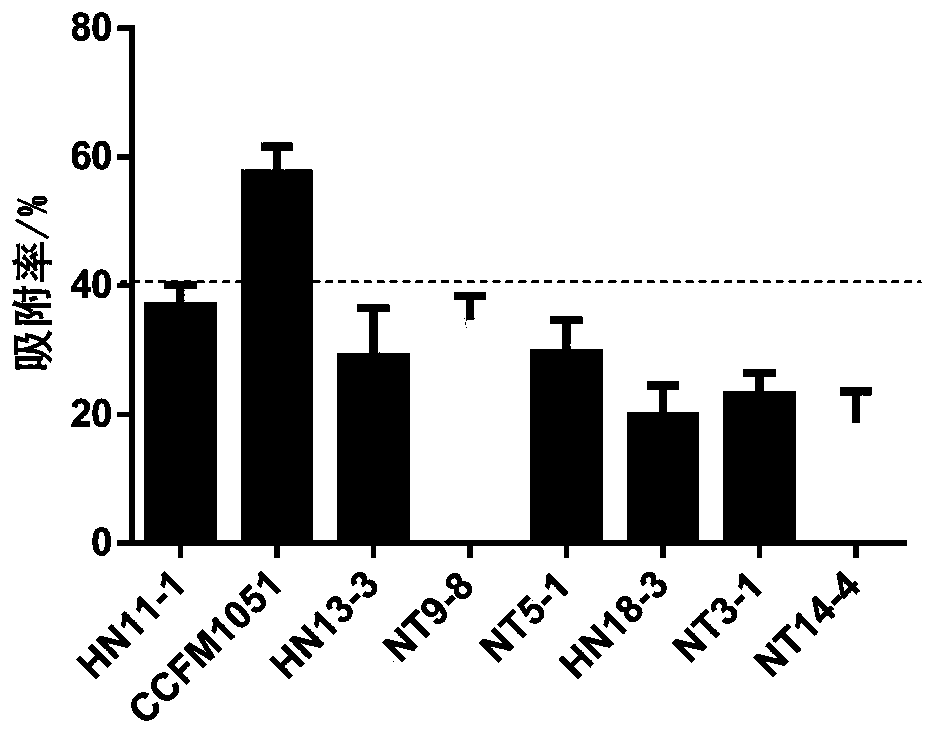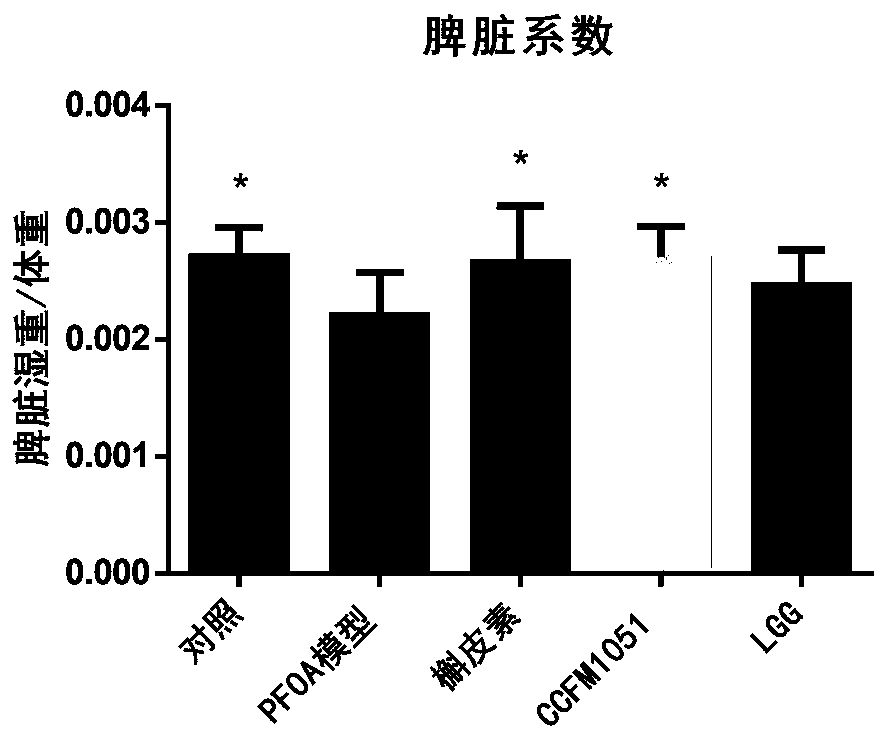Multifunctional lactobacillus fermentum CCFM1051 for relieving PFOA toxicity and fermented foods and application thereof
A technology of CCFM1051 and Lactobacillus fermentum, which is applied in the field of microorganisms, can solve the problems of expensive and difficult to obtain, and achieve the effect of inhibiting oxidative stress, wide application prospects, and alleviating the toxicity of PFOA
- Summary
- Abstract
- Description
- Claims
- Application Information
AI Technical Summary
Problems solved by technology
Method used
Image
Examples
Embodiment 1
[0072] Embodiment 1: Good PFOA adsorption capacity in vitro;
[0073] Cell adsorption Lactobacillus fermentum CCFM1051 was purified and activated, inoculated in MRS liquid medium at 1% (v / v) inoculum, and cultured at 37°C for 18 hours. Then centrifuge at 8000r / min for 5min to collect the bacteria, take the precipitate and clean it with normal saline, then continue to centrifuge at 8000r / min for 5min to remove the precipitate to obtain live bacteria cells, that is, wet bacteria. The wet bacteria were resuspended in 10mg / LPFOA solution, and the final bacterial concentration reached 1g dry bacteria / L (the wet bacteria were resuspended in PFOA-free ultrapure water as a blank control). Use 0.1M NaOH or HCl solution to quickly adjust the pH of the PFOA solution containing bacteria to 3.0, add a small amount of NaOH or HCl (less than 0.5ml), and its ionic strength has negligible influence on PFOA adsorption. Subsequently, the 250ml Erlenmeyer flask containing 100ml of the sample sol...
Embodiment 2
[0078] Embodiment 2: It has good ability to scavenge diphenyltrinitrophenylhydrazine free radical (DPPH) in vitro, scavenge hydroxyl free radical ability and reducing ability;
[0079] After fully mixing 1 mL of lactic acid bacteria complete cell suspension and 1 mL of freshly prepared DPPH absolute ethanol solution (0.2 mmol / L), react in the dark at 37°C for 30 min. Mix DPPH and PBS (pH7.2) as a control sample, and culture under the same conditions. After centrifuging at 7000×g for 10 min, measure the absorbance at 517 nm, and calculate the ability of lactic acid bacteria to scavenge DPPH free radicals according to the following formula:
[0080] DPPH radical scavenging rate (%)=[1-A517 (sample) / A517 (control)]×100%.
[0081] Mix 1 mL of 1,10-phenanthroline, 1 mL of LPBS (pH 7.2), 1 mL of lactic acid bacteria complete cell suspension or 1 mL of FeSO4 (referred to as "mixture 1"). Add 1mL of H2O2 to "Mixture 1", bathe in water at 37°C for 1.5h, measure the absorbance at 536n...
Embodiment 3
[0084] Example 3: Lactobacillus fermentum CCFM1051 can significantly improve spleen atrophy in mice exposed to PFOA;
[0085] Fifty 6-week-old male C57BL / 6J mice were randomly divided into five groups according to body weight after acclimatization for one week: control group, model group, quercetin intervention group, Lactobacillus fermentum CCFM1051 intervention group, LGG intervention group, each group Including 10 mice, animal grouping and treatment methods are shown in Table 2
[0086] Table 2 Grouping and processing methods of animal experiments
[0087]
[0088]
[0089] The mice in Example 3 were weighed on the 13th day, then euthanized, the spleen was taken out and weighed wet to calculate the organ coefficient, and the organ coefficient of the mouse spleen was calculated according to the following formula:
[0090] Spleen organ coefficient = wet weight of spleen / weight of mouse before euthanasia
[0091] Experimental results such as image 3 As shown, the res...
PUM
| Property | Measurement | Unit |
|---|---|---|
| diameter | aaaaa | aaaaa |
Abstract
Description
Claims
Application Information
 Login to View More
Login to View More - R&D
- Intellectual Property
- Life Sciences
- Materials
- Tech Scout
- Unparalleled Data Quality
- Higher Quality Content
- 60% Fewer Hallucinations
Browse by: Latest US Patents, China's latest patents, Technical Efficacy Thesaurus, Application Domain, Technology Topic, Popular Technical Reports.
© 2025 PatSnap. All rights reserved.Legal|Privacy policy|Modern Slavery Act Transparency Statement|Sitemap|About US| Contact US: help@patsnap.com



